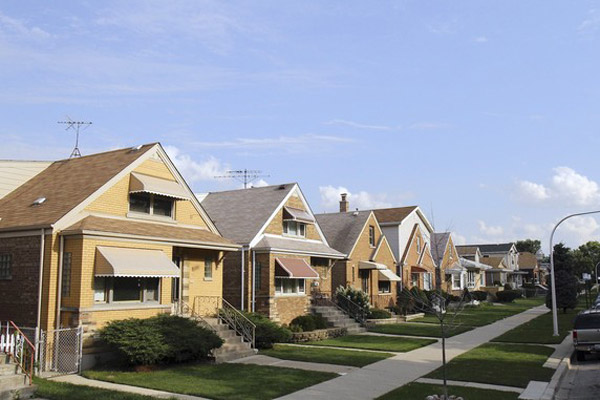
Chicago is justly proud of its bungalows: stout, well-built, handsome structures that were "the first really 'modern' house for the working class." So I've always wondered what would happen if architects returned to the form. What would we get? Would it look anything like a bungalow?
MoMA asked Jeanne Gang to address the housing problems of bungalow-dense Cicero, one of my favorite architectural regions of Chicagoland (along with neighboring Berwyn). Gang's response, as she and Greg Lindsay wrote in the New York Times, was to just break it up:
Most of Cicero’s housing is detached, single-family homes. But these are too expensive for many immigrants, so five or six families often squeeze into one of Cicero’s brick bungalows. This creates unstable financial situations, neighborhood tensions and falling real estate values.
Too often, we see such mismatches as a purely financial issue. But instead of forcing families to fit into a house, what if we rearranged the house to fit them?
This doesn’t mean bulldozing Cicero’s housing stock. Instead, it means using existing, underused properties that might be renovated to provide a better fit. In Cicero’s case, that might mean turning to the scores of abandoned factories around it.
Over at MoMA's site, you can see Studio Gang's modular approach to Cicero housing, and how it represents both an old and new approach to urban housing. The "vertical neighborhood" is nothing new; Gang is working within the tradition of the city's most famous residential building, the "city within a city" of Marina City, Le Corbusier's Radiant City, and so on. It's an old modernist dream, and one that's gotten a bad rap in the wake of modern architecture's dead end: public housing. How much architecture has to do with the failure of massive public-housing complexes is controversial, but fair or not, the one-size-fits-you reputation dogs the vertical-city concept.
What Gang took from Cicero is that bungalows, which have so long represented nuclear family units, are already being turned into communal neighborhood space even with the barriers their design entails. For Studio Gang, the next step was obvious:
Team members asked, "What if the bungalow could be taken apart and sorted into separate pieces—bedroom, kitchen, lawns—and reassembled as needed?" Their response is the Recombinant House, which remains affordable because people may buy only the parts they need and add or subtract spaces as families grow, shrink, or change.
In short, it's an attempt to combine the best aspects of apartment and condo living (affordability, financial flexibility) and private homes (flexibility of use), a clever means of addressing the central complaint of the vertical-neighborhood concept.
Gang and her team (which included artist and urban planner Theaster Gates) are smart to identify the architectural aspect of the housing crisis and address it with her architectural idea. But it's still more of a financial problem than a physical one, and Gang's Recombinant House would require a different approach to the financing of the space. It's closest in physical nature to a condo, and that's what Gang and Lindsay's financial scheme resembles as well:
One long-term solution would be a type of co-op in which residents buy and sell shares according to their changing needs and circumstances. Unlike traditional co-ops, residents could purchase shares corresponding only to the units they occupy, not the land beneath, which remains in the hands of a “community land trust.” Such a structure would keep housing costs down while limiting residents’ exposure to the market. It would also provide a backstop for struggling homeowners, since the trust would have the legal right to step in and assist residents in the event of foreclosure.
A couple years ago, just after the bubble burst, the Trib's Mary Ellen Podmolik described how ritzy Highland Park (2011 median home price: $405,000) used a land trust to keep surprisingly sophisticated housing affordable for its teachers, bureaucrats, and public-safety officers:
Started six years ago, the Highland Park Community Land Trust so far has completed 30 housing units, including 14 units at Hyacinth Place, a townhouse development completed earlier this year that features 3-bedroom, 2 1/2 -bath units with two-car garages, geothermal heating systems, bamboo flooring and other "green" features like a wind turbine that powers common areas. The units, appraised at $365,000 apiece, sold for $165,000 to $239,000 and only one remains.
When Hyancith Place was in the works, Dennis Rodkin previewed it:
The complex, which will also have four rental apartments and several important green features, is a good example of what can happen when a municipal government throws its weight behind the idea that the people who work in a town ought to be able to afford to live there.
[snip]
The townhouses have a spacious three-bedroom layout on three levels, not counting the garage, and will feature attractive contemporary styling outside (in other words, they won’t look like anything less than a good addition to the neighborhood). A wind turbine that generates electricity to power all common-area lighting will sit atop one of the complex’s three buildings. The rest of the roofing is highly reflective, to cut down on heat absorption, and the structures will have energy efficient walls and windows. Native plants needing little water are planned for outside, and there will be sustainably grown bamboo flooring inside.
The most exciting of the green touches is the geothermal heating/cooling system, the first I know of in a suburban multifamily development. Geothermal systems rely on the steady temperature below ground to help cool homes in the summer and heat them in the winter, dramatically reducing the use of air conditioners and furnaces.
Gang was joined by longtime Chicago journalist Kari Lydersen for the presentation as part of the "Public Dreams and Private Needs" symposium:
Photograph: Chicago Tribune



